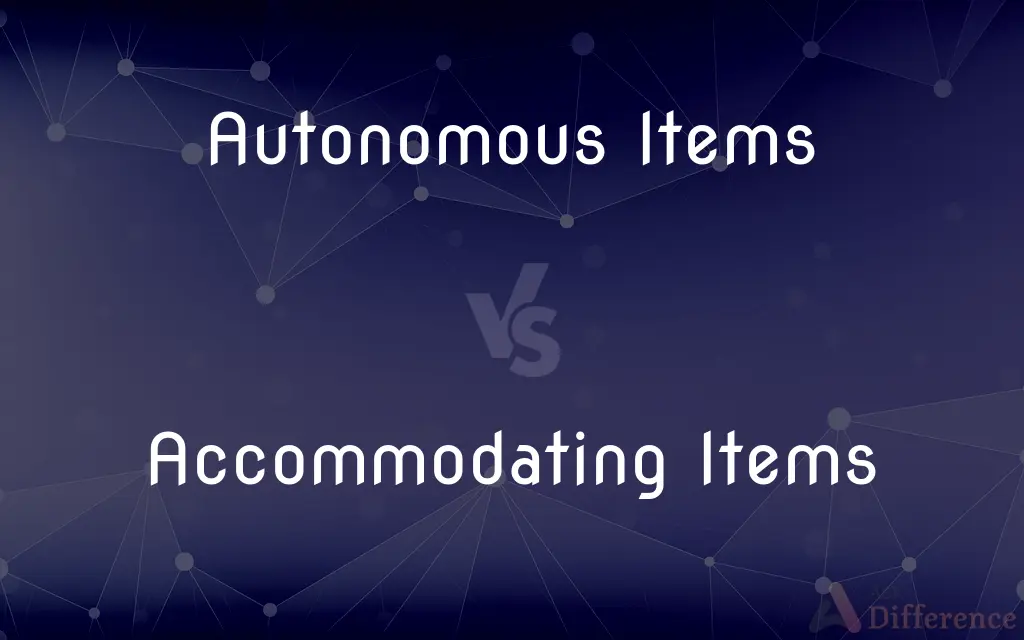Autonomous Items vs. Accommodating Items — What's the Difference?
By Tayyaba Rehman — Published on December 4, 2023
Autonomous Items function independently, whereas Accommodating Items adapt to specific needs or conditions. Both types differ in operation and adaptability.

Difference Between Autonomous Items and Accommodating Items
Table of Contents
ADVERTISEMENT
Key Differences
Autonomous Items refer to things that operate or function on their own, without external interference or control. These items are designed to perform tasks or functions without requiring human intervention. For example, an autonomous robot vacuum cleans without needing human guidance. Accommodating Items, on the other hand, are those that adjust or modify their behavior based on specific requirements or external conditions.
Accommodating Items are flexible and adapt to different situations or user needs. They're designed to provide a tailored experience or function based on external conditions or preferences. For instance, an accommodating chair might adjust its contours based on the user's body shape. In contrast, Autonomous Items prioritize self-sufficiency and consistent operation, regardless of external conditions.
One key difference between Autonomous Items and Accommodating Items is their relationship with the environment. While Autonomous Items generally remain unaffected by their surroundings, Accommodating Items actively respond to them. An autonomous clock will keep ticking regardless of the room's light conditions, while an accommodating lamp might adjust its brightness based on ambient light.
In terms of user interaction, Autonomous Items often require minimal to no input post-setup. They're set to operate in a specific manner and do so without constant adjustments. Accommodating Items, however, might need more frequent interactions or inputs, as they're designed to adapt and provide optimized performance based on changing conditions or user preferences.
Comparison Chart
Operation
Independent operation
Adapts based on conditions
ADVERTISEMENT
User Interaction
Minimal to none post-setup
Might require frequent adjustments
Flexibility
Consistent operation
Tailored experience based on needs
Environment Response
Generally unaffected
Actively responds to surroundings
Design Priority
Self-sufficiency
Optimization for user or conditions
Compare with Definitions
Autonomous Items
Items that require minimal human input post-setup.
The autonomous coffee maker brewed at the same time every morning.
Accommodating Items
Items designed to optimize performance based on conditions.
The accommodating fan adjusted its speed based on room temperature.
Autonomous Items
They are self-sufficient products or tools.
Among the display of Autonomous Items was a self-watering plant pot.
Accommodating Items
These items require interaction for optimal use.
The accommodating smart speaker adjusted its volume based on ambient noise.
Autonomous Items
They function based on pre-set parameters.
The autonomous alarm rang daily at 7 AM, regardless of weekends.
Accommodating Items
Accommodating Items cater to individual preferences or external factors.
The accommodating headlights adjusted brightness based on the surrounding darkness.
Autonomous Items
Autonomous Items operate without external intervention.
The drone, one of the Autonomous Items, flew its route without human control.
Accommodating Items
They provide flexibility in function or usage.
Among the Accommodating Items on sale were adjustable standing desks.
Autonomous Items
Autonomous Items prioritize consistent, independent functioning.
The autonomous thermostat maintained room temperature without manual adjustments.
Accommodating Items
Accommodating Items adjust based on specific needs.
The accommodating mattress changed firmness levels based on user preference.
Common Curiosities
Are all smart devices considered Autonomous Items?
Not necessarily. While some smart devices are autonomous, others might be accommodating, adapting to user needs or conditions.
Which items might need more user interaction?
Accommodating Items might require more user interaction to optimize their performance.
How do Accommodating Items adapt?
Accommodating Items adjust their function or behavior based on specific requirements or conditions.
In what scenarios are Accommodating Items most useful?
Accommodating Items are useful in varied environments or for users with specific needs or preferences.
Which is more user-friendly, Autonomous or Accommodating Items?
It depends on the context. Autonomous Items are user-friendly in set-and-forget situations, while Accommodating Items excel in customizability.
What's the main feature of Autonomous Items?
Autonomous Items operate independently without needing external control.
Can Autonomous Items adjust to changes?
Typically, Autonomous Items operate based on pre-set parameters and don't adapt like Accommodating Items.
Do Autonomous Items always need a power source?
Most Autonomous Items need a power source, but the type and frequency of power depend on the item.
Can Autonomous Items learn over time?
Some advanced Autonomous Items, especially those with AI, can learn over time, but this isn't a universal feature.
What's a challenge with Autonomous Items?
Since they operate on pre-set parameters, Autonomous Items might not adapt to unexpected changes or unique situations as Accommodating Items would.
Can a device be both autonomous and accommodating?
Yes, some advanced devices can operate autonomously while also having accommodating features.
Can Accommodating Items save energy?
Yes, by adapting to conditions, Accommodating Items can optimize performance and potentially save energy.
Are Accommodating Items typically more expensive?
Not necessarily, but advanced accommodating features might come at a higher price point.
Do Accommodating Items always need manual adjustments?
No, some Accommodating Items might use sensors or AI to automatically adjust based on conditions.
Which is more common in smart homes: Autonomous or Accommodating Items?
Both types are common in smart homes, depending on the function and user preference.
Share Your Discovery

Previous Comparison
Hydrangeas vs. Rhododendrons
Next Comparison
Speed Post vs. CourierAuthor Spotlight
Written by
Tayyaba RehmanTayyaba Rehman is a distinguished writer, currently serving as a primary contributor to askdifference.com. As a researcher in semantics and etymology, Tayyaba's passion for the complexity of languages and their distinctions has found a perfect home on the platform. Tayyaba delves into the intricacies of language, distinguishing between commonly confused words and phrases, thereby providing clarity for readers worldwide.
















































